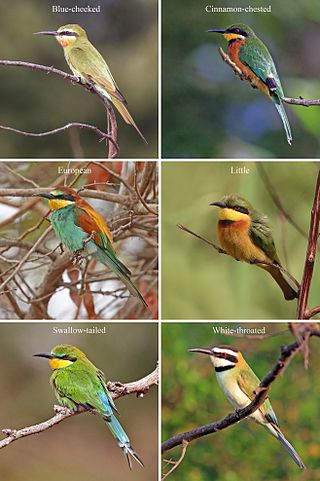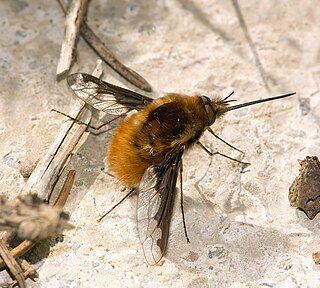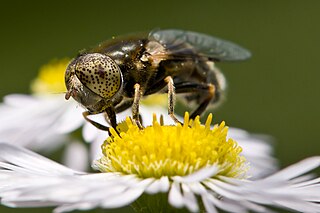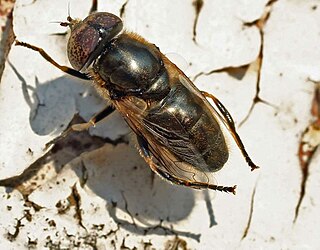
The bee-eaters are a group of birds in the family Meropidae, containing three genera and thirty species. Most species are found in Africa and Asia, with a few in southern Europe, Australia, and New Guinea. They are characterised by richly coloured plumage, slender bodies, and usually elongated central tail feathers. All have long down-turned bills and medium to long wings, which may be pointed or round. Male and female plumages are usually similar.

Flies are insects of the order Diptera, the name being derived from the Greek δι- di- "two", and πτερόν pteron "wing". Insects of this order use only a single pair of wings to fly, the hindwings having evolved into advanced mechanosensory organs known as halteres, which act as high-speed sensors of rotational movement and allow dipterans to perform advanced aerobatics. Diptera is a large order containing an estimated 1,000,000 species including horse-flies, crane flies, hoverflies, mosquitoes and others, although only about 125,000 species have been described.

A pollinator is an animal that moves pollen from the male anther of a flower to the female stigma of a flower. This helps to bring about fertilization of the ovules in the flower by the male gametes from the pollen grains.

Hoverflies, also called flower flies or syrphids, make up the insect family Syrphidae. As their common name suggests, they are often seen hovering or nectaring at flowers; the adults of many species feed mainly on nectar and pollen, while the larvae (maggots) eat a wide range of foods. In some species, the larvae are saprotrophs, eating decaying plant and animal matter in the soil or in ponds and streams. In other species, the larvae are insectivores and prey on aphids, thrips, and other plant-sucking insects.

The Bombyliidae are a family of flies, commonly known as bee flies. Adults generally feed on nectar and pollen, some being important pollinators. Larvae are mostly parasitoids of other insects.

A megadiverse country is one of a group of nations that harbours the majority of Earth's species and high numbers of endemic species. Conservation International identified 17 megadiverse countries in 1998. All of them are at least partially in the tropics.

Eristalis tenax, the common drone fly, is a common, migratory, cosmopolitan species of hover fly. It is the most widely distributed syrphid species in the world, and is known from all regions except the Antarctic. It has been introduced into North America and is widely established. It can be found in gardens and fields in Europe and Australia. It has also been found in the Himalayas.
Craugastor rugosus is a species of rain frog in the family Craugastoridae. It is found in Costa Rica and southwestern Panama, and possibly southern Nicaragua.
Lithobates vibicarius, commonly known as either green-eyed frog or Rancho Redondo frog, is a species of frog in the family Ranidae from highland rainforests in Costa Rica and western Panama.

Eristalinus taeniops is a species of hoverfly, also known as the band-eyed drone fly.

Eristalinus is a genus of hoverfly. Most species have very distinctive eye marking in the form of spots or banding, though these features may fade on some preserved specimens. Most are stout flies, and are nimble flyers, even compared to other hoverfly species.

Eristalinus aeneus, the common lagoon fly, is a fairly common species of syrphid fly observed throughout the United States and Europe. Hoverflies can remain nearly motionless in flight. The adults are also known as flower flies for they are commonly found on flowers, from which they get both energy-giving nectar and protein-rich pollen. The larvae occurs along shorelines in rock pools containing large amounts of decaying seaweed.

Eristalinus sepulchralis is a European species of hoverfly. The species are brownish-white from a close up, and look like a wasp. From a distance though, they are yellowish-black coloured, and look like a bumble bee. The species can be found throughout Europe in the Baltic states, North Europe, Central, Southern and Western Europe and across the Palaearctic to Kamchatka, Japan, China and India. Finland, Great Britain, Hungary, Ireland, Norway, and the Netherlands.

Eupeodes corollae is a very common European species of hoverfly. Adults are 6–11 millimetres (0.24–0.43 in) in body length. Males and females have different marking on the abdomen; males have square commas on tergites 3 and 4, whereas females have narrow commas. Larvae feed on aphids. This species has been used experimentally in glasshouses as a method of aphid control, and to control scale insects and aphids in fruit plantations. They were found to be partial to the fruit, eating more fruit than aphids.

Merodon is a large genus of bee-like hoverflies. The majority of the species are centered on the Mediterranean and it is the second largest hoverfly genus in Europe with more than 50 European species. It is distributed over the Palaearctic and Afrotropical realms, with most European species occurring in Southern and Eastern Europe. The centre of distribution of this genus appears to be Turkey, where about 65 species have been recorded. Some species occur in Africa and the middle East, as far as Pakistan. Given the rate at which new species have been recorded over the past decades, the worldwide number of species could exceed 200. The larvae feed on the bulbs or rhizomes of monocotyledons.

Toxomerus is a very large genus of hoverflies. They are found in many parts of North and South America. Most larvae are predators on soft bodied insects, though a few species have been shown to feed on pollen. Adults feed on the pollen of a wide range of flowers.

Trichopsomyia is a genus of Hoverflies, from the family Syrphidae, in the order Diptera.

Eristalinus tabanoides is a species of hoverfly that inhabits the Old world.

Hovering is the ability exhibited by some winged animals to remain relatively stationary in midair. Usually this involves rapid downward thrusts of the wings to generate upward lift. Sometimes hovering is maintained by flapping or soaring into a headwind; this form of hovering is called "wind hovering", "windhovering", or "kiting".





















